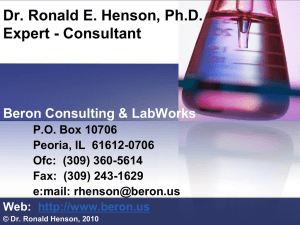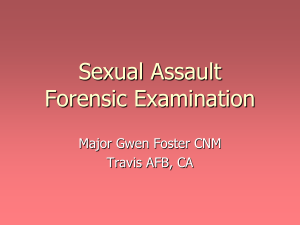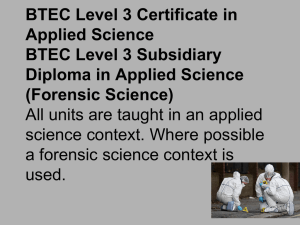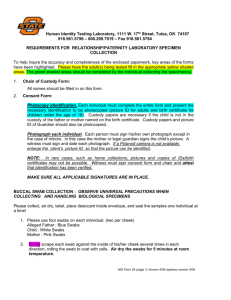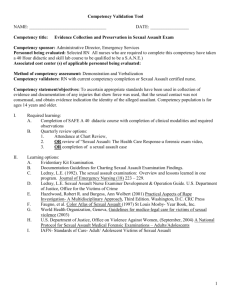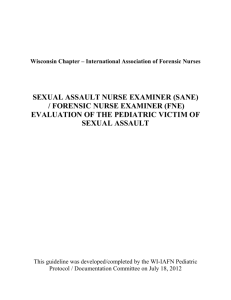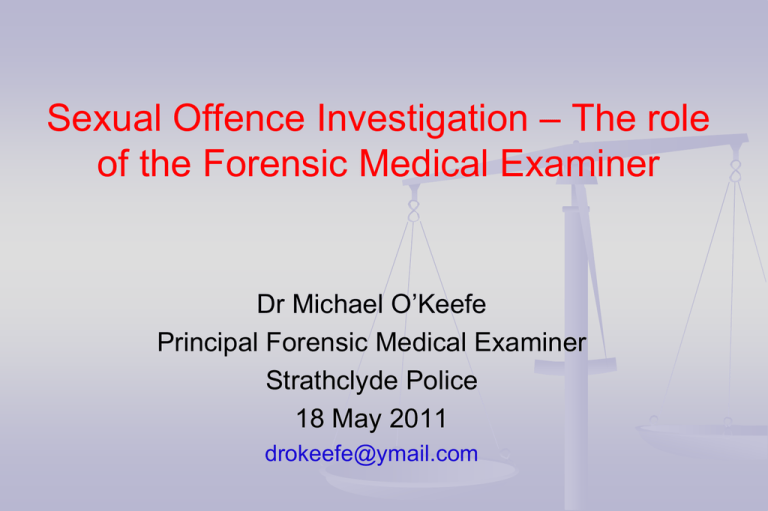
Sexual Offence Investigation – The role
of the Forensic Medical Examiner
Dr Michael O’Keefe
Principal Forensic Medical Examiner
Strathclyde Police
18 May 2011
drokeefe@ymail.com
Sexual Assault - The Role of the FME
To provide best professional service to –
1.
Complainer - health needs take absolute priority
2.
Police - collection of trace evidence (secondary)
3.
Fiscal - formal detailed report is required
4.
Court - give witness to findings & opinion
Doctor - Patient Relationship
Explain my role of “dual responsibility”- clinical & forensic
Examination can only proceed with consent - only valid if fully informed
Explain procedure and reasons for samples - facilitates consent
Confidentiality issues must be explained i.e. report may be available to
police; fiscal; court; “experts”
Patient must be assured she/he is in control (complainer)
Obtain appropriate consent (verbal / written) and proceed
The Forensic History
Complaint taken by police officer (SOLO)
Specific enquiries about the complaint made to officer
Recent consensual intercourse
Was force used - type, when, where? (body site)
Was resistance offered - any injuries inflicted on
assailant?
The Medical History
Medical history – taken by FME
General medical – including prescribed drugs
Obstetric – SVD / CS
Gynaecological – specific procedures
Psychiatric – sensitive enquiry
The Forensic Examination
Dr should provide professional courtesy and sensitivity not
sympathy – must remain “clinical” and objective
General examn. - note demeanour, mood, sobriety
General - head to toe - complainer may be unaware of injury?
Genitalia - structured & detailed - including negatives
Anal examination - only when appropriate?
Video-colposcopy is now the expected standard
General Examination & Injuries
Record an accurate description of any injury with -
Site of injury - inc anatomical landmarks
Specific sites - mouth; lips; throat; wrists; inner thighs & knees
Nature of injury - bruises, abrasions, lacerations, incised wounds,
restraint injuries
Size & shape - measured in cm
Age - fresh, healing, old (caution with bruises – “within timescale”)
Injuries - Genital (T.E.A.R.S.)
Tears (or lacerations)
Ecchymosis (or bruising)
Abrasions
Redness ?
Swelling ?
Genital structures to be examined
Vulva - bruises; abrasions, lacerations ?
Labiae majorae ``
Labiae minorae -
Posterior fourchette -
Vestibule -
Clitoris -
Urethra -
Hymen -
Vagina -
``
Forensic samples in sexual assault
Urine sample - drug assisted sexual assault
Clothing - all clothing - paper bags - trace material
Sheet of paper - complainer stands on - hairs/fibres
Venous blood - toxicology (not DNA)
Saliva and/or mouth swab - spermatozoa; DNA
Skin swabs (UV light - c.f. false positives)
Forensic samples in sexual assault contd.
Fingernail scrapings - clippings less popular
Head hair - cut - semen / D.A.S.A. (50 strands)
Pubic hair - combed & cut - (no longer plucked) taped?
Vulval / vaginal swabs - external; low & high vaginal
Anal swabs - only if appropriate
Penile swabs (suspect) - vaginal DNA; faecal; DNA other source
(victim) - saliva cf child sexual abuse
Forensic Samples - Pubic Hair
Pubic hair transfer following intercourse
A study (USA) recorded pubic hair transfer in
- 17% of cases
- female to male in 23%
- male to female in 11%
(Source – USA student campus volunteers)
Vaginal Samples & Forensic Evidence
“A low vaginal swab is obtained by passing the swab into
the vagina under direct vision avoiding contact with the
external genitalia. However even when taken very
carefully it is difficult to refute the accusation that in taking
the swab contamination (external) had been introduced;
its value is therefore questionable”
Howitt J, Rogers D “Adult Sexual Offences and Related Matters” in Clinical Forensic
Medicine 2nd Ed, 1996, Greenwich Medical Media, 203.
Vaginal Samples & Forensic Evidence
No internationally agreed format: MPFSL dry swabs vulval (external) x 2; high vaginal x 2; low vaginal x 2
1.
Vulval swabs x 2 (wet + dry)
2.
Insert speculum into vagina - 2 dry high vaginal
3.
Speculum almost removed - 2 dry swabs (low)
Newton M. “The sexual assault examination kit” in Forensic Gynaecology. 2004. RCOG Press 116.
Rogers D, Newton M. “Sexual Assault Examination” in Clinical Forensic Medicine - A Physician’s
Guide 2nd Ed. 2005 Humana Press 87,88.
Anal & Peri-anal Swabs
Swab area 3 cm radius from anus
If skin appears moist - use dry swab
Skin dry or no obvious stain - use “double swab” technique;
moist then dry swab with circular movements rotating tip
through its long axis. Pressure light - as care is taken to
prevent exfoliation of cells
Anal canal swabs x 2; wet and dry
Rectal swabs x 2 via proctoscope
Forensic Report - Genitalia
Location of all abnormalities recorded 12 hour clock
All areas should be examined - vulva, labiae majorae, labiae
minorae, fossa navicularis, clitoris, urethra, hymen, vagina
and P.F. incl. negative findings
Hymen should be described in detail (in children)
Each structure - signs of injury, recent or old
Anus and peri-anal margin - recent or old injury
Detection Time Limits
Spermatozoa
Seminal Fluid
Vagina
6 days
12-18 hours
Anus
3 days
3 hours
Mouth
Clothing/
Bedding
24 hrs (max 31)
until washed
1 hour
until washed
Questions for FME to answer
Has an assault taken place and if so, when?
Is there evidence of restraint or resistance?
Was its nature sexual?
What trace evidence is available?
Was there ejaculation, and, if so, where?
Did intercourse (vaginal/oral/anal) occur ????
Points to remember for court ?
It might be considered wise to remind the court It is accepted in enlightened medical circles that further
research must be carried out in an attempt to identify
clinical findings in the genitalia which would be accurate
and reliable indicators that intercourse was nonconsensual as opposed to consensual.
More Points ?
Give opinion on any general injuries i.e.
1.
2.
3.
“The injuries are consistent with blunt force trauma”
“These are commonly found on victim of assault”
“Appearance is consistent with time frame alleged”
Give opinion on any genital injuries i.e.
1.
2.
3.
“There is no evidence of recent genital trauma”
“There is evidence of recent genital trauma”
“The injuries are consistent with blunt force trauma”
Even More Points ?
It may be appropriate for the doctor to conclude –
“The clinical findings - are consistent with the allegation”
Cameron H. “The statement” in Forensic Gynaecology (2004) RCOG Press;169.
The doctor should NEVER state –
“The medical findings are consistent with rape”
since rape is not a medical diagnosis but a legal concept and a
determination to be made by the court.
Roberts R. “The doctor in court” in Forensic Gynaecology (2004) RCOG Press; 182.




